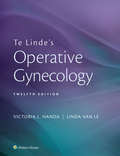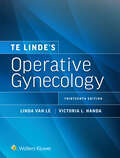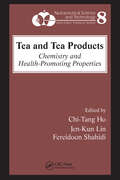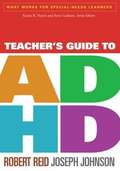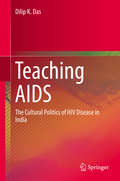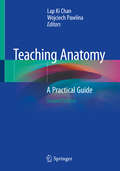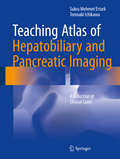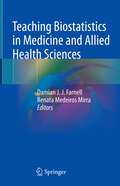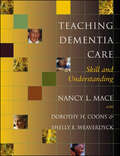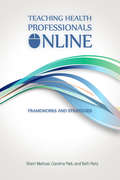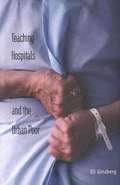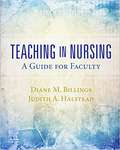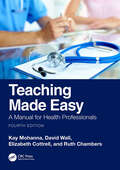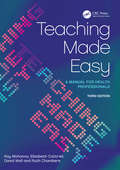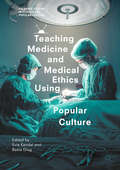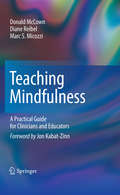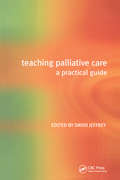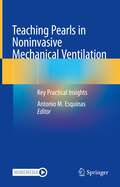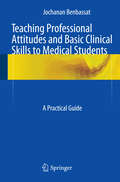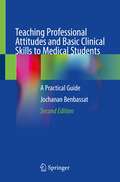- Table View
- List View
Te Linde's Operative Gynecology
by Victoria Handa Linda Van LeTe Linde’s Operative Gynecology, Twelfth Edition, remains your authoritative resource on the comprehensive perioperative care of gynecologic patients. New features in this edition include a primer on anesthesia, a chapter on positioning for pelvic surgery, a practical review of pediatric gynecology, and a section on the use of surgical instruments. All chapters have been updated to reflect contemporary gynecologic practice and the latest minimally invasive surgical approaches. New illustrations are included and each chapter includes step-by-step descriptions of surgical techniques. Today’s best surgeons and teachers offer a readable, intuitive, and concise reference for trainees as well as the experienced gynecologist.
Te Linde’s Operative Gynecology
by Linda Van Le Victoria L. HandaWith expert guidance on all aspects of gynecologic surgery, Te Linde’s Operative Gynecology, Thirteenth Edition, edited by Drs. Linda Van Le and Victoria L. Handa, remains your go-to-resource from preoperative to postoperative care. Comprehensive, step-by-step instructions on how to perform all contemporary gynecologic procedures, updated diagnostic and management approaches, a greatly expanded illustration program, and new procedural videos, edited by Dr. Danielle Patterson, make this classic text an ideal reference for trainees as well as experienced practitioners.
Tea and Tea Products: Chemistry and Health-Promoting Properties (Nutraceutical Science and Technology)
by Fereidoon Shahidi Chi-Tang Ho Jen-Kun LinThe past decade has seen considerable interest and progress in unraveling the beneficial health effects of tea, particularly its polyphenolic components and its antioxidant activity. Understanding the science behind the claims will help in the production and marketing of teas and tea products. Pulling together recent research and presenting it in a
Teacher's Guide to ADHD
by Joseph Johnson Robert ReidMeeting a key need for teachers, this book provides practical, data-based tools for helping students with attention-deficit/hyperactivity disorder (ADHD) succeed in the classroom. The authors combine instructional expertise with extensive knowledge about the nature and treatment of ADHD. Coverage includes ways to support students and teach them needed strategies in core areas: academic skills, behavior, self-regulation, and social skills. Step-by-step instructions and concrete examples help teachers implement effective interventions and accommodations. The book also offers crucial guidance for teaming with other school professionals and with parents.
Teaching AIDS: The Cultural Politics of HIV Disease in India
by Dilip K. DasThis book approaches the subject of AIDS pedagogy by analysing the complex links between representation or discourse, ideology, power relations and practices of self, understood from the perspective of embodiment. While there is a fairly large amount of literature available on the social, economic, psychological and policy dimensions of the epidemic, there is virtually nothing on its cultural politics. As a critique of the national AIDS pedagogy, this book attempts to fill the gap. It addresses important issues in cultural studies, body studies, medical humanities, disease control policy and behaviour change communication strategies. This book will be of interest to researchers and students of culture studies and social sciences, especially social anthropology, community health, health management. and gender studies.
Teaching Anatomy: A Practical Guide
by Lap Ki Chan Wojciech PawlinaThe field of anatomy is dynamic and fertile. The rapid advances in technology in the past few years have produced exciting opportunities in the teaching of gross anatomy such as 3D printing, virtual reality, augmented reality, digital anatomy models, portable ultrasound, and more. Pedagogical innovations such as gamification and the flipped classroom, among others, have also been developed and implemented. As a result, preparing anatomy teachers in the use of these new teaching tools and methods is very timely. The main aim of the second edition of Teaching Anatomy – A Practical Guide is to offer gross anatomy teachers the most up-to-date advice and guidance for anatomy teaching, utilizing pedagogical and technological innovations at the forefront of anatomy education in the five years since the publication of the first edition. This edition is structured according to the teaching and learning situations that gross anatomy teachers will find themselves in: large group setting, small group setting, gross anatomy laboratory, writing examination questions, designing anatomy curriculum, using anatomy teaching tools, or building up their scholarship of teaching and learning. Fully revised and updated, including fifteen new chapters discussing the latest advances, this second edition is an excellent resource for all instructors in gross anatomy.
Teaching Atlas of Hepatobiliary and Pancreatic Imaging
by Sukru Mehmet Erturk Tomoaki IchikawaFeaturing 137 carefully selected cases, this atlas covers virtually every aspect of clinical cross-sectional imaging of the liver, gallbladder, biliary system and pancreas. For the vast majority of the cases, both CT and MR images are included to demonstrate the different features of each lesion. Furthermore, both typical and atypical pathologies are included to facilitate the differential diagnosis in daily clinical practice. Concise yet comprehensive,this atlas includes not only imaging features of the lesions but also the related pathologic and clinical data. It is therefore useful both as a quick guide for practicing radiologists and as a brief textbook for radiologists in training.
Teaching Biostatistics in Medicine and Allied Health Sciences
by Damian J. J. Farnell Renata Medeiros MirraThis book discusses the theory and practice of teaching biostatistics to students in the life sciences, in particular medical and dental trainees and researchers, as well as its crucial importance to biomedical research and evidence-based health care. Specific tools and resources to biostatistics teaching (e.g., “R shiny”) are described, and how they can be used effectively to increase interaction with students and improve engagement with the subject. The book is structured into three parts: teaching and learning of statistics in medicine and allied health sciences; the move to online learning and online learning methods, especially in light of the impact of COVID-19; and computer tools and resources. It provides a unique insight into teaching biostatistics to medical and dental students from some of the most prominent biostatisticians who also have a very strong interest in biostatistics pedagogy. Biostatistics teaching is important for maintaining the quality of biomedical research and also in evidence-based medicine, both of which are key to the health and well-being of the world population. This book is particularly useful to readers who are new to the field of biostatistics teaching as well as to more experienced teachers as it presents the latest accounts of the teaching and learning of biostatistics, recent experiences of increased use of online teaching, and useful computer resources and tools for teaching biostatistics.
Teaching Cultural Competence and Cultural Humility in Medical Education: A Practical Guide
by Freddy A. PaniaguaTraining in multicultural issues is an area of increasing focus in medical education internationally. In the United States specifically, the inclusion of the topic in training programs is among the key criteria established by the Liaison Committee on Medical Education (LCME) for approval of schools of medicine, where Standard 7.6 deals with "Structural Competence, Cultural Competence, and Health Inequities." This new textbook provides a culturally sensitive framework to address the major elements in the LCME Standard 7.6 and to address related requirements for including multicultural issues in the curriculums of medical schools around the world.Key Features The first book in the field to provide a framework to help approved medical schools and those in the submission process for approval in the United States to respond appropriately to Standard 7.6 in the LCME This framework also supports the design of culturally sensitive curriculums in medical schools outside the United States Provides specific guidelines to equip future physicians with the skills to take the culturally sensitive approaches they must use when assessing, diagnosing, and treating culturally diverse patients in order to ensure optimal outcomes for patients Helps medical educators and schools to specify where and how in the curriculum students are best trained to become culturally competent and the need also to display attributions of cultural humility during clinical encounters with clients/patients With a practical approach, the book provides invaluable hands-on guidance to students seeking to develop their skills, knowledge, and competence in this area. Additionally, by specifying where and how in the curriculum students can be trained to be culturally competent, the book serves as an essential reference for educators and medical schools seeking support in the development and implementation of a culturally appropriate curriculum.
Teaching Dementia Care: Skill and Understanding
by Nancy L. MaceDementia afflicts millions of Americans and deeply affects the lives of their loved ones. Good care has been proven to have a significant effect on the quality of life of a person with dementia. To ensure good care, staff members of nursing homes, assisted living facilities, and adult day-care centers, and providers of home care must be thoroughly and continually trained by qualified and well-prepared professionals.Nancy L. Mace, coauthor of The 36-Hour Day, has created the ultimate teachers' guide for dementia care training. Rich with information and with tools for effective communication between teacher and student, the text supplies instructors with in-depth lessons and includes relevant charts, tables, and handouts, which may be customized to suit specific programs. Good training is the foundation for a confident and competent caregiver and supports the dignity and well-being of persons with dementia and their families. With her unmistakable compassion, humor, and wisdom, Mace has provided a much-needed guidebook for better teaching and better care.
Teaching Environmental Health to Children
by David W. Hursh Hilarie B. Davis Camille A. Martina Michael A. TrushEvery day we are exposed to toxins and toxicants that can impact our health. Yet we rarely teach elementary and secondary students about these exposures and how they can reduce their risk to them. In this book we highlight activities and curriculum developed at nine universities in the United States from a grant funded by the National Institute of Environmental Health Sciences. Our goal is to extend these lessons to a global audience and for classroom teachers of all subjects and age levels to include environmental health in their teaching. 'An invaluable tool for equipping informed citizens to think about the environment and its human impacts --both the science, and equally important, the social and ethical dimensions' , Howard Frumkin, M.D., Dr. P.H., Dean, School of Public Health, University of Washington, Seattle, WA, USA
Teaching Health Professionals Online: Frameworks and Strategies
by Beth Perry Sherri Melrose Caroline ParkTeaching Health Professionals Online: Frameworks and Strategies is a must-read for professionals in the health care field who strive to deliver excellence in their online classes. Intended for a wide range of professionals, including nurses, social workers, occupational and radiation therapists, chiropractors, dietitians, and dental hygienists, this compendium of teaching strategies will inspire both new and experienced instructors in the health professions. In addition to outlining creative, challenging activities with step-by-step directions and explanations of why they work, each chapter in the text situates practice within the context of contemporary educational theories such as instructional immediacy, invitational theory, constructivism, connectivism, transformative learning, and quantum learning theory. Melrose, Park, and Perry also address other issues familiar to those who have taught online courses. How can a distance instructor build teacher-student relationships? How does one transform the assumptions often held by students in the health fields from the confines of the virtual classroom? Most importantly, how can the instructor support his or her students in their future pursuits of knowledge and their development as competent professionals? By considering these and other concerns, this handbook aims to help instructors increase student success and satisfaction, which, the authors hope, will ultimately produce the best possible patient care.
Teaching Hospitals and the Urban Poor
by Eli GinzbergAcademic health centers (AHCs) have played a key role in propelling the United States to world leadership in technological advances in medicine. At the same time, however, many of these urban-based hospitals have largely ignored the medical care of their poor neighbors. Now one of the leading experts in American health policy and economics ponders whether current and proposed changes in the financing and delivery of medical care will result in a realignment between AHCs and the poor. Basing his discussion on an analysis of the nation's twenty-five leading research-oriented health centers, Eli Ginzberg and his associates trace the history of AHCs in the twentieth century. He claims that AHCs are once again moving toward treating the poor because these hospitals need to admit more Medicaid patients to fill their empty beds, and their medical students need opportunities to practice in ambulatory sites. He also assesses some of the more important trends that may challenge the AHCs, including financial concerns, changing medical practice environments, and the likelihood of some form of universal health insurance.
Teaching In Nursing: A Guide For Faculty
by Diane M. Billings Judith A. HalsteadThe perfect all-in-one guide for future nurse educators! The award-winning Teaching in Nursing: A Guide for Faculty, 6th Edition prepares you for the day-to-day challenges of teaching future nurses for practice in today's rapidly evolving healthcare system. This comprehensive resource is the only one of its kind to cover all four components of nursing education: teaching and learning, curriculum, evaluation, and technology-empowered learning. You’ll benefit from the expert guidance on such key issues as curriculum and test development, diverse learning styles, the redesign of healthcare systems, and advances in technology and information. Plus, the 6th edition includes a unique new chapter on Global Health and Curricular Experiences along with updated information on technology-empowered learning, the flipped classroom, interprofessional education, interprofessional collaborative practice, and much more.
Teaching Made Easy: A Manual for Health Professionals
by Kay Mohanna Elizabeth Cottrell David Wall Ruth ChambersThe fourth edition of this highly respected book builds on the excellent reputation of its predecessors. Fully revised and updated throughout, it continues to provide essential structure, support, guidance and tips for both beginning and experienced teachers and their managers, both in the UK and internationally. Pitched at an introductory level with an emphasis on practical tips and application of theory, rather than focussing heavily on scholarly research, its content is designed to be relevant and inclusive to all healthcare disciplines. Key points are highlighted by the inclusion of tips from experienced teachers in each chapter, while throughout chapters reflect contemporary concepts and key approaches, including teaching styles, curriculum development, e-learning, virtual learning environments, leadership and professionalism. Teaching Made Easy, 4E will continue to benefit everyone teaching health professionals at all levels, from general practitioners and hospital doctors, nurses in primary and secondary care, and professionals allied to medicine and health service managers, and will also support the development of colleagues in new roles such as physician associates, FCPs and newer nursing associates.
Teaching Made Easy: A Manual for Health Professionals, 3rd Edition
by Kay Mohanna Elizabeth Cottrell David Wall Ruth ChambersThe Third Edition of this highly respected book has been further refined following feedback and consultation; it continues to provide essential structure, support, guidance and tips for both beginning and experienced teachers and their managers. The new edition has been developed for use by both UK and international teachers. Its content is designed to be relevant and inclusive to all healthcare disciplines, and has been thoroughly reorganised to ensure more intuitive placement of information. Key points are highlighted by the new inclusion of Tips from experienced teachers in each chapter, while newly-written chapters reflect contemporary concepts and key approaches, including teaching styles, curriculum development, e-learning, virtual learning environments, leadership and professionalism. This book will continue to benefit everyone teaching health professionals at all levels, including general practitioners and hospital doctors, nurses in primary and secondary care, professionals allied to medicine and health service managers. From reviews of previous editions: 'A useful book for those with a genuine interest in the full gamut of education' - ANNALS OF THE ROYAL COLLEGE OF SURGEONS OF ENGLAND 'Comprehensive and easy to understand. If you are looking for a book that will help you develop your teaching skills and to open your mind to the broader aspects of teaching in the healthcare setting then this is a gem not to be missed. For once it is a book that lives up to its title.' - SCOTTISH JOURNAL OF HEALTHCARE CHAPLAINCY 'A book which has a considerable relevance for community practice teachers whatever their nursing discipline. The strength of the book is its practical approach to guiding and assessing students in the practice setting.' - JOURNAL OF COMMUNITY NURSING
Teaching Medical Professionalism
by Yvonne Steinert Richard L. Cruess Sylvia R. Cruess Cruess, Richard L. and Cruess, Sylvia R. and Steinert, YvonneUntil recently professionalism was transmitted by respected role models, a method that depended heavily on the presence of a homogeneous society sharing values. This is no longer true, and medical schools and postgraduate training programs in the developed world are now actively teaching professionalism to students and trainees. In addition, licensing and certifying bodies are attempting to assess the professionalism of practising physicians on an ongoing basis. This is the only book available to provide guidance to those designing and implementing programs on teaching professionalism. It outlines the cognitive base of professionalism, provides a theoretical basis for teaching the subject, gives general principles for establishing programs at various levels (undergraduate, postgraduate, and continuing professional development), and documents the experience of institutions who are leaders in the field. Teaching aids that have been used successfully by contributors are included as an appendix and are available in downloadable form on our website.
Teaching Medical Professionalism
by Richard L. Cruess Sylvia R. Cruess Yvonne Steinert Richard L. Cruess Sylvia R. CruessUntil recently professionalism was transmitted by respected role models, a method that depended heavily on the presence of a homogeneous society sharing values. This is no longer true, and medical schools and postgraduate training programs in the developed world are now actively teaching professionalism to students and trainees. In addition, licensing and certifying bodies are attempting to assess the professionalism of practicing physicians on an ongoing basis. This is the only book available to provide guidance to those designing and implementing programs on teaching professionalism. It outlines the cognitive base of professionalism, provides a theoretical basis for teaching the subject, gives general principles for establishing programs at various levels (undergraduate, postgraduate, and continuing professional development), and documents the experience of institutions who are leaders in the field. Teaching aids that have been used successfully by contributors are included as an appendix and are available in downloadable form on our website.
Teaching Medicine and Medical Ethics Using Popular Culture
by Evie Kendal Basia DiugThis book demonstrates how popular culture can be successfully incorporated into medical and health science curriculums, capitalising on the opportunity fictional media presents to humanise case studies. Studies show that the vast majority of medical and nursing students watch popular medical television dramas and comedies such as Grey's Anatomy, ER, House M. D. and Scrubs. This affords us with a unique opportunity to engage and inform not only students but the general public and patients further downstream. This volume analyses examples of medical-themed popular culture and offers various strategies and methods for educators in this field to integrate this material into their teaching. The result is a fascinating read and original resource for medical professionals and teachers alike.
Teaching Mindfulness
by Donald Mccown Diane K. Reibel Marc S. MicozziThe applications and use of mindfulness-based interventions in medicine, mental health care, and education have been expanding as rapidly as the empirical evidence base that is validating and recommending them. This growth has created a powerful demand for professionals who can effectively deliver these interventions, and for the training of new professionals who can enter the fold.Ironically, while the scientific literature on mindfulness has surged, little attention has been paid to the critical who and how of mindfulness pedagogy. Teaching Mindfulness is the first in-depth treatment of the person and skills of the mindfulness teacher. It is intended as a practical guide to the landscape of teaching, to help those with a new or growing interest in mindfulness-based interventions to develop both the personal authenticity and the practical know-how that can make teaching mindfulness a highly rewarding and effective way of working with others. The detail of theory and praxis it contains can also help seasoned mindfulness practitioners and teachers to articulate and understand more clearly their own pedagogical approaches. Engagingly written and enriched with vignettes from actual classes and individual sessions, this unique volume: Places the current mindfulness-based interventions in their cultural and historical context to help clarify language use, and the integration of Eastern and Western spiritual and secular traditionsOffers a highly relational understanding of mindfulness practice that supports moment-by-moment work with groups and individualsProvides guidance and materials for a highly experiential exploration of the reader's personal practice, embodiment, and application of mindfulness Describes in detail the four essential skill sets of the mindfulness teacher Proposes a comprehensive, systematic model of the intentions of teaching mindfulness as they are revealed in the mindfulness-based interventionsIncludes sample scripts for a wide range of mindfulness practices, and an extensive resource section for continued personal and career development Essential for today's practitioners and teachers of mindfulness-based interventionsTeaching Mindfulness: A Practical Guide for Clinicians and Educators brings this increasingly important discipline into clearer focus, opening dialogue for physicians, clinical and health psychologists, clinical social workers, marriage and family therapists, professional counselors, nurses, occupational therapists, physical therapists, pastoral counselors, spiritual directors, life coaches, organizational development professionals, and teachers and professionals in higher education , in short, everyone with an interest in helping others find their way into the benefits of the present moment.
Teaching Mindfulness Skills to Kids and Teens
by Susan Kaiser Greenland Christopher Willard Amy SaltzmanPacked with creative, effective ideas for bringing mindfulness into the classroom, child therapy office, or community, this book features sample lesson plans and scripts, case studies, vignettes, and more. Leading experts describe how to harness the unique benefits of present-focused awareness for preschoolers, school-age kids, and teens, including at-risk youth and those with special needs. Strategies for overcoming common obstacles and engaging kids with different learning styles are explored. Chapters also share ways to incorporate mindfulness into a broad range of children's activities, such as movement, sports, music, games, writing, and art. Giving clinicians and educators practices they can use immediately, the book includes clear explanations of relevant research findings.
Teaching Palliative Care: A Practical Guide
by David JeffreyEducation of healthcare professionals is the cornerstone of specialist palliative services. This book is a practical toolbox of teaching techniques. Accessible, practical and easy to use it will encourage busy clinicians to teach by increasing their confidence in their training abilities. It provides a resource of various tools and describes how to approach teaching in a team, planning, methods and evaluation. Each chapter presents a menu of tried and tested techniques and closes with examples of lesson plans. The multidisciplinary experiences of the contributors are reflected in the book and healthcare professionals working in palliative care, hospitals, hospices or the community will find it to be essential reading.
Teaching Pearls in Noninvasive Mechanical Ventilation: Key Practical Insights
by Antonio M. EsquinasThis book uses real-world clinical case analyses of hot topics to provide insights into noninvasive mechanical ventilation (NIV). Written by leading international teachers and experts, it features a selection of “major controversial topics in clinical practice” and demonstrates how these cases can be used to teach about NIV. It then presents a discussion of the topics in various scenarios (anesthesiology, critical care, emergency, pneumology and sleep medicine, as well). The chapters allow readers to develop a case-by-case understanding of NIV in acute and chronic respiratory disorders, and perioperative and in intensive care patients, also thanks to Electronic Supplementary Materials. Lastly the authors summarize five key points / recommendations. This book is an attractive resource also for universities / educational seminars / national and international postgraduate courses and hot-topics sessions at national/international congresses.
Teaching Professional Attitudes and Basic Clinical Skills to Medical Students
by Jochanan BenbassatThis concise, easy to read title is designed for clinical teachers looking to refine their approach to teaching professional attitudes and basic skills to medical students. Doctors differ in values, training and practice setting, and eventually they adopt diverse approaches to patient interviewing, data collection and problem-solving. As a result, medical students may encounter significant differences in the clinical methods of their tutors. For example, some doctors encourage patients' narratives by using open-ended questions while others favor closed-questions; and hospital- and community-based doctors may disagree on the value of the physical examination. Medical students may be puzzled by these differences and by controversies about issues, such as doctor-patient relations and the approaches to clinical reasoning. This handy title is intended to help tutors address many of these issues, and to provide an approach not only to teaching patient interviewing and the physical examination but to teaching some clinically relevant topics of the behavioral and social sciences that are so vital to developing an effective, well-rounded physician.
Teaching Professional Attitudes and Basic Clinical Skills to Medical Students: A Practical Guide
by Jochanan BenbassatThe second edition of this concise, easy-to-read title is designed for clinical teachers looking to refine their approach to teaching professional attitudes and basic skills to medical students. The core sections on communication skills, physical examination, and clinical reasoning have been fully updated; and the book has been expanded to cover such topics as the role of the social and behavioral sciences in clinical care, quality assurance of patient care, and the rationing of medical resources in clinical practice. On all topics, the renowned author clearly and adroitly offers keen insights gleaned from his long career, explaining the importance of these topics and how students form their own opinions about them. For example, writes the author, the primary goal of teaching the social and behavioral sciences is to raise awareness that age, low socioeconomic status, recent life events, drug dependence, mental illness, high body mass index, and belonging to an ethnic minority are risk indicators for morbidity. Second, the author address second opinions, outlining how not getting a second opinion is a cause of health care disparities. In addition, the author discusses how unexpected study results should not be ignored, nor should they be considered definitive evidence, but rather hypotheses that should be tested by further studies. Teaching Professional Attitudes and Basic Clinical Skills to Medical Students: A Practical Guide, 2nd Edition will be of great assistance to teachers who must provide an approach not only to teaching patient interviewing and the physical examination but to teaching key, clinically relevant topics of the behavioral and social sciences that are so vital to developing an effective, well-rounded physician.
